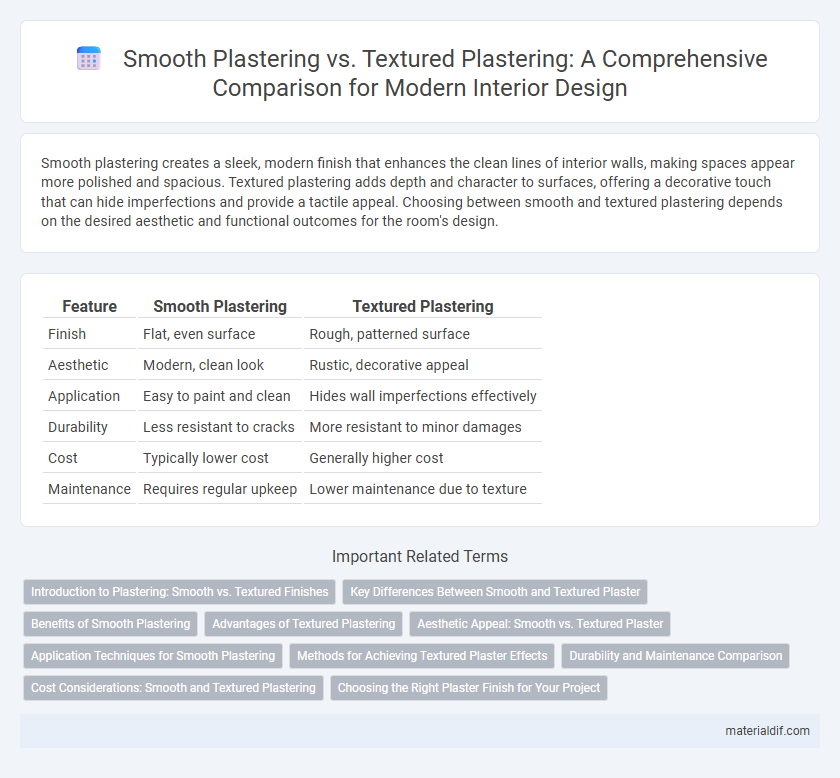Smooth plastering creates a sleek, modern finish that enhances the clean lines of interior walls, making spaces appear more polished and spacious. Textured plastering adds depth and character to surfaces, offering a decorative touch that can hide imperfections and provide a tactile appeal. Choosing between smooth and textured plastering depends on the desired aesthetic and functional outcomes for the room's design.
Table of Comparison
| Feature | Smooth Plastering | Textured Plastering |
|---|---|---|
| Finish | Flat, even surface | Rough, patterned surface |
| Aesthetic | Modern, clean look | Rustic, decorative appeal |
| Application | Easy to paint and clean | Hides wall imperfections effectively |
| Durability | Less resistant to cracks | More resistant to minor damages |
| Cost | Typically lower cost | Generally higher cost |
| Maintenance | Requires regular upkeep | Lower maintenance due to texture |
Introduction to Plastering: Smooth vs. Textured Finishes
Smooth plastering creates a sleek, even surface ideal for modern, minimalist interiors, enhancing light reflection and ease of maintenance. Textured plastering adds depth and visual interest, offering styles like stippled, combed, or roughcast finishes that can hide imperfections and improve wall durability. Both techniques use gypsum or cement-based plaster, with the choice influenced by aesthetic preferences and functional needs.
Key Differences Between Smooth and Textured Plaster
Smooth plastering creates a sleek, even surface ideal for modern interiors, emphasizing clean lines and minimalistic aesthetics. Textured plastering offers varied patterns and finishes that add depth and character, often used to hide imperfections or enhance visual interest on walls and ceilings. Key differences include the application technique, finish appearance, maintenance requirements, and suitability for different architectural styles.
Benefits of Smooth Plastering
Smooth plastering creates a sleek, polished surface that enhances the aesthetic appeal of walls by providing a flawless base ideal for painting or wallpapering. It improves light reflection, making spaces appear brighter and more spacious while offering easier maintenance and cleaning compared to textured surfaces. Smooth plaster also helps in reducing dust accumulation and provides better resistance to cracks, ensuring a long-lasting, durable finish.
Advantages of Textured Plastering
Textured plastering offers enhanced durability and resistance to minor surface damages compared to smooth plastering, making it ideal for high-traffic areas. Its varied patterns improve aesthetic appeal while effectively concealing wall imperfections and cracks. The increased surface roughness also enhances paint adhesion, extending the lifespan of decorative finishes.
Aesthetic Appeal: Smooth vs. Textured Plaster
Smooth plastering provides a sleek, modern aesthetic with clean lines that enhance minimalist and contemporary interiors, creating an elegant and polished finish. Textured plastering adds depth and character to walls by introducing patterns and tactile elements, making it ideal for rustic or traditional designs. The choice between smooth and textured plaster significantly impacts the visual appeal, influencing light reflection and room ambiance.
Application Techniques for Smooth Plastering
Smooth plastering requires precise application techniques involving the use of trowels or floats to achieve a flat, even surface free of imperfections. The process includes multiple thin coats, typically a base coat followed by a finishing coat, each carefully leveled and allowed to dry properly. Skilled hand movements and consistent pressure are essential to avoid streaks or lumps, resulting in a sleek, polished finish ideal for modern interior walls and ceilings.
Methods for Achieving Textured Plaster Effects
Textured plastering methods involve techniques such as troweling, stippling, and combing to create varied surface patterns that enhance visual depth and character. Materials like sand, aggregate, or additives are mixed into the plaster to achieve specific textures, while tools including brushes, sponges, and rollers shape the surface finish. These methods allow for customization in appearance, ranging from subtle finishes to bold, decorative effects suitable for interior and exterior applications.
Durability and Maintenance Comparison
Smooth plastering offers a sleek, uniform finish that is easier to clean and maintain, making it highly durable against everyday wear and moisture exposure. Textured plastering, while visually appealing with its patterns and depth, tends to accumulate dust and dirt more easily, requiring more frequent maintenance to preserve its appearance. Durability for both types depends heavily on application quality and environmental conditions, but smooth plaster generally demands less upkeep over time.
Cost Considerations: Smooth and Textured Plastering
Smooth plastering generally incurs higher labor costs due to the meticulous techniques required to achieve a flawless finish, while textured plastering often reduces labor time and expenses by allowing for quicker application. Material costs for both methods vary slightly based on the specific plaster mix used, with textured plaster sometimes requiring additives to create patterns or relief. Budget planning should account for these differences, prioritizing finish preferences alongside cost efficiency to determine the most suitable option for interior or exterior surfaces.
Choosing the Right Plaster Finish for Your Project
Smooth plastering creates a sleek, polished surface ideal for modern interiors, enhancing light reflection and providing a clean backdrop for decor. Textured plastering offers durability and visual interest, concealing imperfections and adding depth to walls in rustic or traditional designs. Selecting the right finish depends on the desired aesthetic, maintenance considerations, and the room's function to ensure long-lasting beauty and performance.
Smooth Plastering vs Textured Plastering Infographic

 materialdif.com
materialdif.com